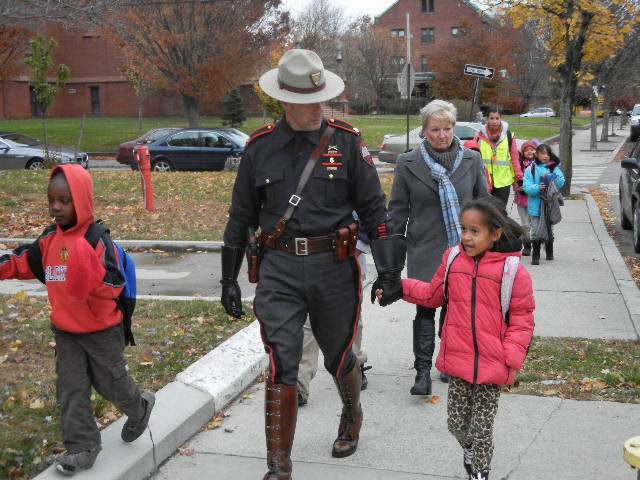This South Providence Elementary School Had a Chronic Absenteeism Problem. Then They Started a Walking School Bus.
At first, the maps didn’t make sense. Why would the kids who lived closest to school – all within one mile – have the most problems with chronic absenteeism?
That’s the question staff at Providence Children’s Initiative (PCI), a Family Service of Rhode Island program working to address chronic absenteeism in the low-income area of South Providence, Rhode Island, asked themselves after mapping out the homes of families in the district that had the most problems with attendance.
Then, PCI figured out that Providence School District doesn’t provide school bus service to families living within one mile of school. For low-income families who aren’t eligible for bus transportation, not owning a car, having parents that work morning shifts, or having children attend different schools meant that transportation was an obstacle to attendance. The students lived close enough to walk to school, but with ages ranging from five to twelve years old, families weren’t comfortable letting them walk alone. That’s when the team at PCI came up with the idea of starting a walking school bus program with volunteer adult chaperones to accompany the kids to school, explained Allyson Trentrseaux, then an intern at PCI.
 Students walk with volunteer Audrey.
Students walk with volunteer Audrey.
The first step was reaching out to the families to explain the idea and get them on board. PCI sent home papers with the students announcing the walking school bus, but there was not much of a response. Then they tried calling homes, but found that many of the numbers were out of order. Finally, Allyson and her team decided to go door-to-door. After visiting with the families and explaining the walking school bus program, PCI found that there was solid support for starting a program that would allow students to walk to school safely.
 The "Blue Line" with volunteer Erin.
The "Blue Line" with volunteer Erin.
The first walking school bus started in September 2012 with one route – the purple line – and six students walking to and from school every day. Now, the program has expanded to two schools, four routes, and 30 kids who walk to and from school every day. Since the program started, 100 percent of participating students have improved their attendance at school.
“The kids love it. Our volunteers are on a consistent schedule so the students can get to know them, and they also get to meet local “celebrities” who walk with them sometimes, such as the Providence Police, the State Police, and even the Governor. Plus, with recess time getting cut, walking to school gives them a chance to get more exercise and be outside,” said Allyson.
Pl AndProvidence Police sometimes accompany students on the walk to school.
AndProvidence Police sometimes accompany students on the walk to school.
The program is so successful that there is now a waitlist of students who want to participate. The only thing holding PCI back from adding more routes is a shortage of volunteers. Some of the walking school bus chaperones are PCI staff, but most are volunteers – including teachers and physical education instructors volunteering their time, members of a local community service organization, and nearby college students. With additional volunteers, PCI hopes to expand the program to reach more kids at Fogarty and Bailey and to serve additional schools in the area.

Rhode Island Governor Chafee gets ready to walk.
Congratulations to Providence Children’s Institute for launching a walking school bus program that makes sure kids are getting to school AND getting active. Does your school or community have a similar story to share about active transportation? Submit your success stories about increasing opportunities for physical activity through Complete Streets, shared use agreements and Safe Routes to School and we might spotlight your story nationally next!

